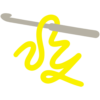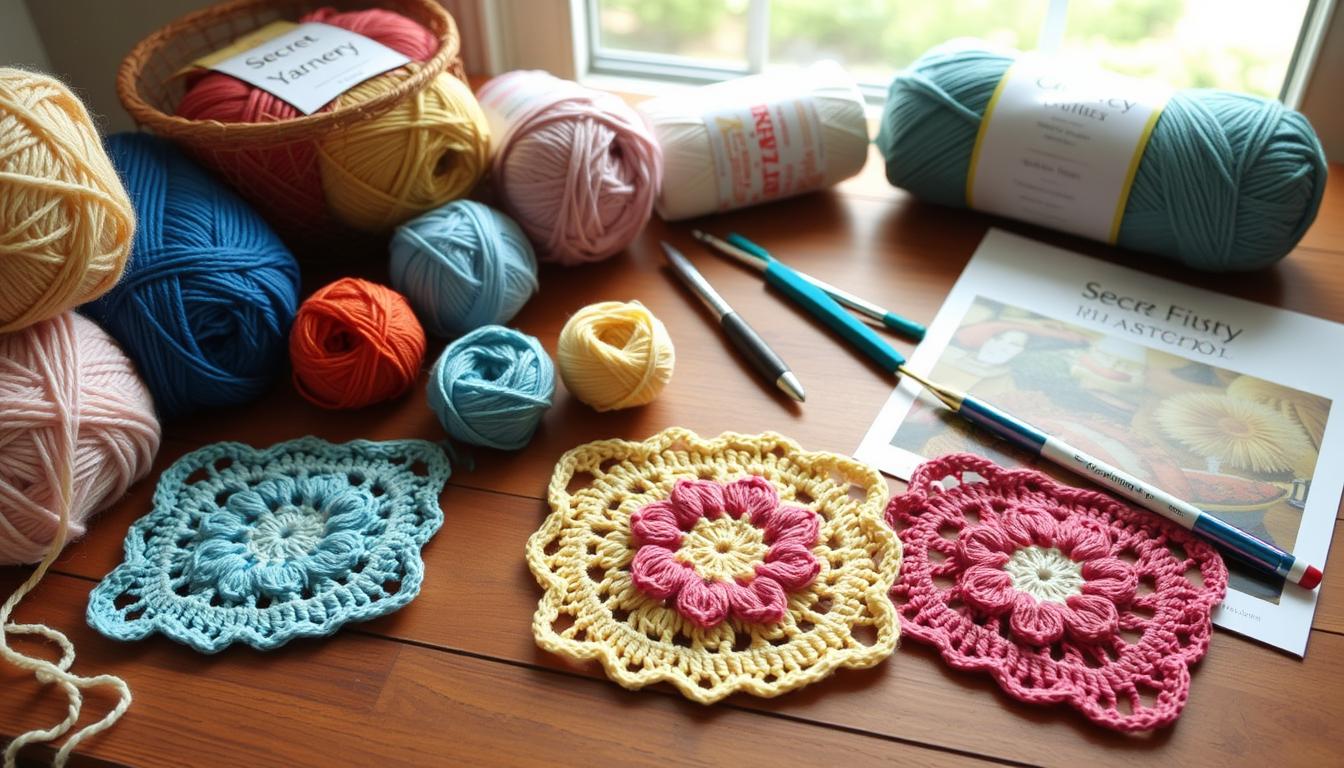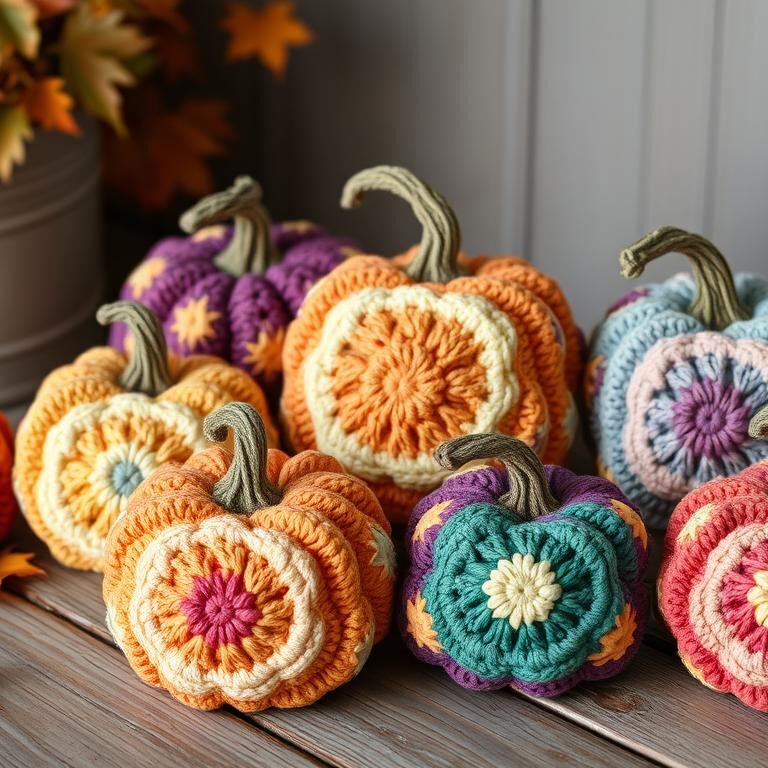Mastering the Basics of Crochet: A Step-by-Step Guide
Are you eager to start crocheting but find yourself feeling overwhelmed by the plethora of information out there? You’re not alone! Many beginners feel lost as they embark on this creative journey. But fear not—this step-by-step guide will serve as your roadmap to mastering the basics of crochet. From understanding various yarn types to exploring essential crochet techniques and discovering fun crochet accessories, we’ve got you covered. With a little patience and practice, you’ll soon find yourself not just crocheting, but unleashing your creativity in the vibrant world of yarn arts. Let’s dive in to this beginner’s guide and get started on transforming those beautifully loops into stunning projects!
Key Takeaways
- Crochet is a popular yarn craft with a rich history and endless possibilities for creating unique items.
- Mastering the fundamental techniques and basic stitches is crucial before moving on to more advanced crochet projects.
- Essential supplies for beginners include a crochet hook, yarn, and additional tools like scissors, yarn needles, and stitch markers.
- Proper yarn and hook selection, as well as mastering the pencil or knife grip, are key to developing good crochet habits.
- Learning how to create a slip knot, chain stitches, and work into the chains are foundational skills for any crochet enthusiast.
What is Crochet?
Crochet is a craft that has been loved for centuries. It comes from many cultures around the world. Unlike knitting, crochet uses just one hook, not two needles.
By using yarn or thread, crocheters make many patterns and designs. They can make simple items like scarves and blankets. Or they can create detailed lace work and cute amigurumi figures.
Understanding the Art of Crochet
Crochet is a craft that many people love. It uses a single hook, which makes it very creative. You can make cozy blankets or cute characters with it.
Crochet Techniques and Applications
Crochet is not just for blankets and scarves. You can make many things, like dishcloths and sweaters. It’s also great for making home decor, like wall hangings and baskets.
Crochet has a special look that’s different from knitting. It lets you show your style and creativity. You can make your home cozy or wear your art.
“Crochet is a craft that has the power to transform the ordinary into the extraordinary.”
Starting your crochet journey is exciting. You’ll learn to express yourself and relax. Every project you finish will bring you joy.
Getting Started: Essential Supplies
Starting your crochet journey is easy. You only need a crochet hook and some crochet yarn. But, having a few extra tools can make it more fun and efficient.
Choosing the Right Yarn
When picking your crochet yarn, think about its weight, fiber, and color. The weight affects your project’s look and feel. Beginners usually prefer a medium-weight yarn, like Lion Brand Wool-Ease or Brava Worsted from WeCrochet.
The yarn’s fiber also matters. Natural fibers like cotton, silk, and wool give unique qualities. Synthetic fibers, like acrylic, are durable and easy to care for.
Selecting the Appropriate Crochet Hook
The size of your crochet hook should match your yarn’s weight. Crochet hooks range from I (5.5mm) to L (8.00mm) for beginners. You can choose from aluminum, steel, plastic, bamboo, or ergonomic hooks from brands like Boye, Susan Bates, and Clover Amour.
Additional Tools for Crochet
- Yarn needles (also called tapestry needles) for weaving in ends and sewing
- Stitch markers to keep track of your work, especially when crocheting in the round
- Sharp scissors for trimming yarn
- A flexible tape measure for gauging project dimensions
As you get better, you might want extra tools. A crochet hook case, project bag, or yarn bowl can help keep things organized and your work neat.
“Crochet is a wonderful, relaxing, and creative hobby that can be enjoyed by people of all ages and skill levels.”
Crochet Basics
Crochet is a fun craft that lets you make many things, like cozy blankets and cool accessories. It starts with basic skills and techniques. Learning these basics opens up a world of creativity and sets you up for success.
Learning to hold the crochet hook and yarn right is key. You can use the pencil grip or knife grip to hold it comfortably. This helps you keep the right tension and stitch accurately.
Knowing how to make a slip knot and chain stitches is also important. The slip knot starts your project, and the chain stitch is the base. Mastering these is the first step to more complex patterns.
As you get better, learning to work into chain stitches and keep the tension right is key. Knowing different stitches, like the single crochet and double crochet, opens up more creative options.
| Crochet Basics | Key Details |
|---|---|
| Holding the Crochet Hook and Yarn |
|
| Slip Knot and Chain Stitches |
|
| Working into Chain Stitches |
|
| Essential Crochet Stitches |
|
Mastering the basics is the first step to a world of creativity. With these skills, you can make amazing crochet projects that show off your style. So, let’s start our crochet journey together!
“Crochet is not just a hobby, it’s a way of life. Once you start, you’ll be hooked (pun intended)!” – Jane Doe, Avid Crocheter
Holding the Crochet Hook and Yarn
Mastering crochet starts with the right hand position and yarn tension. There are two main ways to hold the crochet hook: the pencil grip and the knife grip. It’s important to find a grip that feels comfortable and lets you control the hook well.
Mastering the Pencil Grip
The pencil grip is when you hold the hook like a pencil, between your thumb and index finger. This grip is stable and controlled, making it a favorite among crocheters. To do it, place the hook between your thumb and index finger, and let your other fingers curl around the handle.
Mastering the Knife Grip
The knife grip is similar but with your fingers wrapped around the handle. It’s great for those who get tired hands or wrists. Try both grips to see which one works best for you, keeping your crochet tension and crochet hook grip steady.
Also, learning to manage yarn tension is key for even stitches. Many crocheters wrap yarn around their non-dominant hand’s fingers or weave it through their fingers. Experiment to find what works best for you.
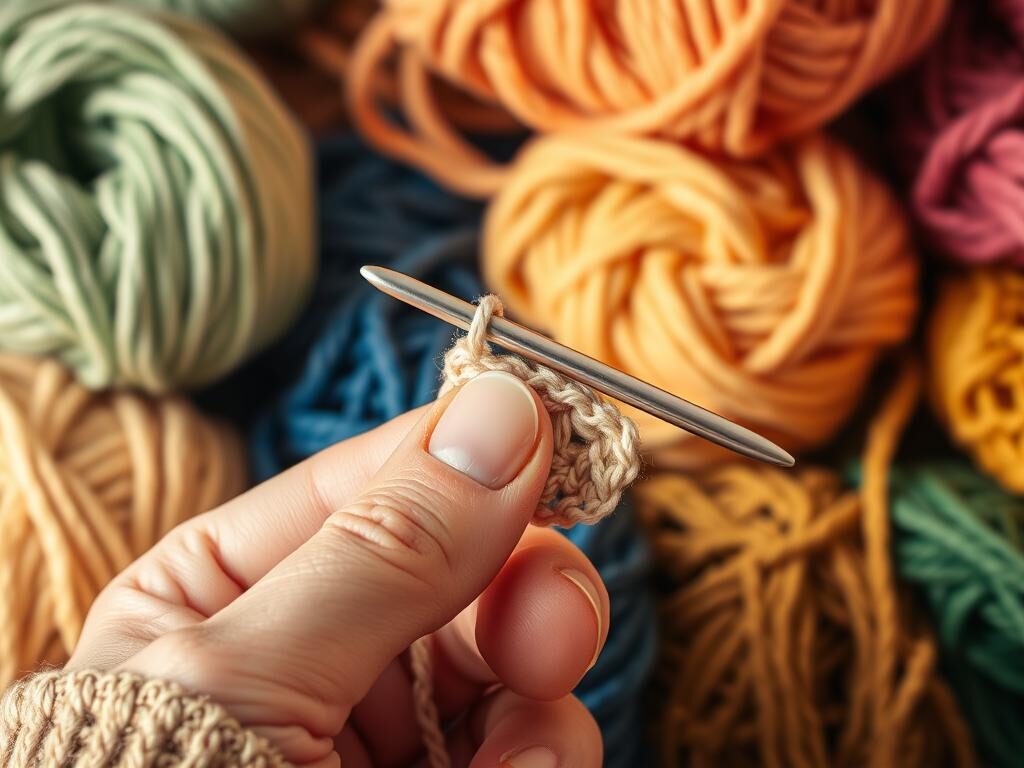
There’s no one “right” way to hold the hook and yarn. What’s important is finding a method that feels natural and comfortable. This way, you can crochet easily and make beautiful stitches.
Creating the Foundation: Slip Knot and Chain Stitches
Crocheting starts with two key steps: the slip knot and the chain stitch. Learning these basics will help you succeed in more complex projects.
How to Make a Slip Knot
The slip knot is the first loop on your crochet hook. It’s vital for starting any crochet project. Here’s how to make one:
- Hold the yarn with your non-dominant hand, leaving a 6-inch tail.
- Use your dominant hand to form a loop, bringing the yarn end behind the standing yarn.
- Insert the crochet hook into the loop and pull the yarn end through, creating a new loop on the hook.
- Gently tighten the slip knot, ensuring it slides easily on the hook.
Working Chain Stitches
Chain stitches are the base of your crochet project. To make a consistent chain, keep the yarn tension even. Here’s how to do it:
- With the slip knot on your hook, yarn over (bring the yarn over the hook from back to front).
- Pull the yarn through the slip knot loop, forming a new loop on the hook. This is your first chain stitch.
- Continue yarning over and pulling the yarn through the previous loop to create additional chain stitches.
- Remember to keep the tension on the yarn consistent, and move your left thumb and index finger up the chain as you work to maintain even stitches.
Learning the slip knot and chain stitches is the first step in your crochet journey. With practice, you’ll get better at creating a strong, even foundation for all your future projects.
Counting and Working into Chain Stitches
Counting and working into crochet chain stitches is key for great results. The first row can be hard for beginners. Knowing the chain’s structure and using tips can help you get better.
Counting stitches is vital for accurate work. Mistakes can make your project look wrong or not fit right. It’s especially important for things you wear.
Spotting the V shapes in the foundation chain helps count correctly. Stitches in rows are easier to count because they’re clearer. The V shape along the top helps spot stitches in rows.
Counting in rounds can be tricky. Stitch markers help keep track. If you make a mistake, you’ll need to go back and fix it.
- Check rows for discrepancies and potential errors.
- Undo rows incrementally to isolate the mistake.
- Ensure a thorough recount after each adjustment.
Crocheting into the back hump of a chain is common for starting or adding to a project. For filet crochet and other patterns, crocheting into the top two loops of a chain is used. Knowing the chain’s structure is crucial for following patterns.
| Crochet Technique | Description |
|---|---|
| Crocheting into the Back Hump of a Chain | Produces an outer edge that looks like the top of a traditional stitch. |
| Crocheting into the Top Two Loops of a Chain | Achieves the same result as crocheting into the back hump, with a neat effect and no twisted chains. |
Mastering counting and working into chain stitches will help you make beautiful crochet projects. Practice, be patient, and use video tutorials if needed.
Essential Crochet Stitches
Crochet is a versatile craft that lets you make many things, like cozy blankets and intricate clothes. At its core are the essential stitches that are the building blocks of your projects. The single crochet and double crochet are two of the most basic and versatile stitches. Learning these stitches will give you a solid foundation for your crochet journey.
How to Single Crochet
The single crochet stitch, or SC, is the most basic and essential stitch in crochet. To create a single crochet stitch, follow these steps:
- Insert your crochet hook into the designated stitch or area.
- Yarn over, or pull the yarn through the stitch.
- Pull the yarn through the first loop on your hook.
- Yarn over and pull the yarn through the remaining two loops on your hook.
Single crochet stitches can be worked in different ways, like in a chain, in a row, or in a round. Each way has slight variations in technique. Mastering the single crochet stitch will give you a solid foundation for your crochet projects.
How to Double Crochet
The double crochet stitch, or DC, is another versatile and beginner-friendly crochet technique. To create a double crochet stitch:
- Yarn over your hook.
- Insert the hook into the designated stitch or area.
- Yarn over and pull the yarn through the stitch, creating three loops on your hook.
- Yarn over and pull the yarn through the first two loops on your hook.
- Yarn over and pull the yarn through the remaining two loops on your hook.
The double crochet stitch is taller than the single crochet, making it great for creating lofty, textured fabrics. Mastering both the single and double crochet stitches will prepare you for a wide range of crochet projects.
Remember, practice makes perfect when it comes to crochet. By following the step-by-step instructions and developing the necessary muscle memory, you’ll become a confident and skilled crocheter.
Finishing Techniques and Edging
As a passionate crocheter, I’ve learned that the true beauty of a project lies not only in the intricate stitches but also in the final finishing touches. Properly finishing your crochet work can elevate the overall appearance and ensure the longevity of your creations. One of the most impactful finishing techniques is adding a decorative crochet edging.
The crab stitch is a subtle and sophisticated finish that creates a delicate, textured edge, perfect for adding a refined touch to your blankets and garments. For a dainty-looking finish, the shell edging is a wonderful option, complementing the soft drape of your crochet fabric. If you’re seeking a more decorative edge, the picot edging with its charming chain stitches is a delightful choice.
Looking to add some visual interest to your project? The block edging, with its “leaning DC groups,” offers a unique and eye-catching finish that seamlessly transitions from the body of your work. And for a classic, timeless look, the blanket edging (also known as the spike stitch) is reminiscent of the beloved blanket stitch in embroidery.
| Edging Technique | Description | Recommended Use |
|---|---|---|
| Crab Stitch | A subtle, sophisticated finish with a textured edge | Blankets, garments |
| Shell Edging | A dainty, delicate finish that complements soft fabrics | Blankets, garments |
| Picot Edging | A decorative edge with charming chain stitches | Blankets, accessories |
| Block Edging | A unique, eye-catching finish with “leaning DC groups” | Afghans, home decor |
| Blanket Edging | A classic, timeless look reminiscent of the blanket stitch | Blankets, throws |
The tutorial I recently discovered offers a comprehensive guide on three distinct crochet edging options: Crab Stitch, Mini Picot, and Cathedral Edging. Each technique is described as fairly basic and quick to complete, making them accessible for crocheters of all skill levels.
One key tip the tutorial emphasizes is the importance of blocking your work before adding the edging. This crucial step ensures your edges are perfectly straight and your stitches are clearly visible, elevating the overall appearance of your finished project.
Whether you’re crocheting a cozy blanket, a delicate shawl, or a charming accessory, incorporating a thoughtfully chosen edging can truly make your creation shine. I encourage you to explore the various options and find the one that best complements your unique crochet style and project. Happy crocheting!
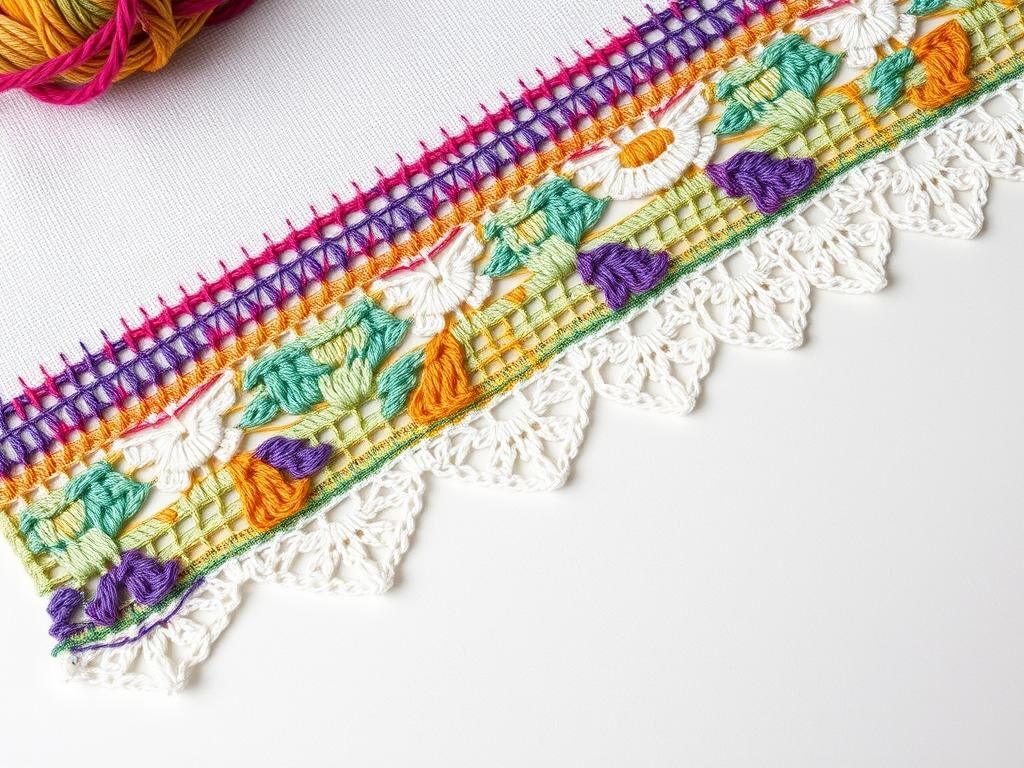
Reading and Understanding Crochet Patterns
Learning to crochet opens up a world of creativity. It lets you tackle complex projects and make your crochet dreams come true. To do this, you need to know how to read crochet patterns. These patterns use crochet terminology and abbreviations that you must understand.
Knowing pattern language and structure boosts your confidence. It helps you follow instructions and finish your crochet projects successfully.
Crochet Pattern Terms and Abbreviations
Crochet patterns assume you know the basics before starting. So, it’s crucial to grasp common terms and abbreviations. The pattern’s first section usually has the pattern name, designer, materials, project size, and copyright info.
When you read a pattern, you’ll see many crochet stitch abbreviations. For example:
- ch (chain)
- sc (single crochet)
- dc (double crochet)
- sl st (slip stitch)
- inc (increase)
- dec (decrease)
- mc (magic circle)
Remember, some abbreviations can differ by region. For instance, sc means single crochet in the US but double crochet in the UK.
| Crochet Abbreviation | Definition |
|---|---|
| ch | Chain |
| sc | Single crochet |
| dc | Double crochet |
| sl st | Slip stitch |
| inc | Increase |
| dec | Decrease |
| mc | Magic circle |
Learning these common crochet pattern terms and abbreviations is key. It helps you read and follow patterns with confidence. This way, you can bring your creative projects to life.
Conclusion
Learning the basics of crochet opens up a world of creativity and fun. This guide covers the essential crochet basics, tools, and strategies. It will help you become a skilled crocheter.
If you’re new to crochet or want to improve, this guide has you covered. It offers practical tips and knowledge to start your crochet adventure. You’ll learn to make beautiful, handmade items.
The journey of crochet is about patience, practice, and enjoying the art. Embrace the process, celebrate your achievements, and explore crochet’s endless possibilities. Happy crocheting!
FAQ
What is crochet and how does it differ from knitting?
Crochet is a craft that uses a hooked needle to make fabric. It’s like knitting but uses one needle instead of two. This allows for detailed patterns and designs.
What are the essential supplies needed to get started with crochet?
To start crocheting, you need a crochet hook and yarn. But, tools like scissors, yarn needles, and stitch markers can also help. A measuring tape is useful too.
How do I hold the crochet hook and yarn properly?
There are two ways to hold the crochet hook: the pencil grip and the knife grip. Choose the one that feels right for you. It’s also important to manage the yarn tension well.
What are the basic crochet stitches I should learn as a beginner?
The single crochet and double crochet are key stitches for beginners. Learning these will help you make many different crochet projects.
How do I read and follow crochet patterns?
It’s important to learn how to read crochet patterns. This includes understanding terms and abbreviations. Knowing pattern language helps you follow instructions and create your crochet projects.
Source Links
- Crochet Step by Step – https://www.dk.com/us/book/9781465402073-crochet-step-by-step/
- How to Crochet for Beginners: A Complete Guide – https://sarahmaker.com/how-to-crochet/
- How to Crochet for Beginners – https://www.lionbrand.com/pages/how-to-crochet?srsltid=AfmBOor7a8HTbCLU1hyCmZx4FwlqpBnnJDGAbbsqbK9jvNQHtxAsNyFY
- How to Crochet for Beginners – https://www.lionbrand.com/pages/how-to-crochet?srsltid=AfmBOorcz4FFr43Sg_4TAZfFyFMz3ucNAVrazpTH7yZyN4iHZVx3Zk54
- What is Crochet? and How to Get Started – https://sarahmaker.com/what-is-crochet/
- The 7 Essential Crochet Supplies that Beginners Actually Need – https://sarahmaker.com/crochet-supplies/
- Crochet Supplies for Beginners – What Do You Need to Start Crocheting? – https://makeanddocrew.com/crochet-supplies/
- How to Crochet for Beginners – https://www.lionbrand.com/pages/how-to-crochet?srsltid=AfmBOop4ycXpvZEim6PLbdlByRKV6ivpL7-yhH7O2EYxW08rZCVQHXr9
- How to Crochet for Beginners – https://www.thesprucecrafts.com/how-to-crochet-for-beginners-979092
- How to Crochet for Beginners: A Complete Step-by-Step Guide – https://blog.bellacococrochet.com/how-to-crochet/
- How to hold a crochet hook and yarn – Beginner tutorial – https://www.cillacrochets.com/crochet-tutorials/learning-crochet-how-to-hold-your-crochet-hook-and-yarn
- How to Hold Your Crochet Hook and Yarn: Tips on Tension – https://www.sigonimacaroni.com/how-to-hold-your-crochet-hook-and-yarn/
- Breakdown of 6 ways on How to Hold Crochet Yarn and Hook — Pocket Yarnlings — Pocket Yarnlings – https://www.pocketyarnlings.com/blog/how-to-hold-crochet-yarn-and-hook
- Slip Knot, Chain and Slip Stitch – https://www.crochet365knittoo.com/slip-stitch/
- No title found – https://www.anniescatalog.com/crochet/content.html?content_id=1&srsltid=AfmBOoqTu0KczzgaqSqzCR8ojoKrUzIv4ik13z8CVIiIyZlM2BTG0-bc
- How to Count Crochet Stitches and Chains — byGoldenberry – https://www.bygoldenberry.com/blog/how-to-count-crochet-stitches-and-chains?srsltid=AfmBOor3cbYcKoL0UxKwprb6aaaXjpXi1-Slx3_29I7U80WAL0kbEzwk
- How to crochet into chains two ways – Dora Does – https://doradoes.co.uk/2022/09/28/how-to-crochet-into-chains-at-the-start-and-in-the-middle-of-a-project/
- Basic Crochet Stitches Every Beginner Needs – Mama In A Stitch – https://www.mamainastitch.com/basic-crochet-stitches-for-beginners/
- 6 Basic Crochet Stitches for Beginners (Learn These First!) – https://sarahmaker.com/basic-crochet-stitches/
- How to Learn Basic Crochet Stitches step by step for Absolute Beginners – 6 Easy Steps! — Pocket Yarnlings — Pocket Yarnlings – https://www.pocketyarnlings.com/blog/learn-basic-crochet-stitches-step-by-step
- 5 Crochet Edges That’ll Beautifully Finish Any Project – https://www.craftsy.com/post/5-crochet-edges-you-should-know
- Crochet Edgings – MatayaMade – https://matayamade.com/2017/12/10/crochet-edgings/
- How to read crochet patterns – https://www.cillacrochets.com/crochet-tutorials/how-to-read-a-crochet-pattern
- How to Read Crochet Patterns for Total Beginners – https://tlycblog.com/how-to-read-crochet-patterns-for-total-beginners/
- Crochet basics, how much do you know ? – L’atelier de Pandora – https://www.latelier-de-pandora.com/crochet/crochet-basics-how-much-do-you-know/
- What I’ve Learned My First Year of Crochet – https://www.sigonimacaroni.com/what-ive-learned-my-first-year-of-crochet/
